Videos
Further video recommendations
Gaslighting
If you do not see the video here, please use another browser or click here: www.youtube.com/watch?v=SVCqTcb4qkM.
The film follows a successful young marketing executive, who after moving in with her charming photographer boyfriend is in danger of losing everything, as she becomes increasingly unsure of her ability to trust her own memory.
Duration: 20 min
Training videos
Excursus – Gender: Intersectionality
Further tasks for reflection
Please watch the video and make notes to the following questions:
(1) Name some examples of intersectionality.
(2) In what ways have you observed or experienced privilege or discrimination based on the intersection of your own social categories?
(3) Reflect how intersectionality can affect access to opportunities, resources, and representation in various fields or settings (e.g., education, employment, media, health sector).
(4) Have you ever been in a situation where you witnessed someone experiencing discrimination due to the intersection of their various categories? How did you respond, and what could have been done differently?
Most common forms of violence in the context of domestic violence: Coercive control
Special types of violence in the context of domestic violence: Female Genital Mutilation/Cutting (FGM/C)
Victims of domestic violence
If you do not see the video here, please use another browser or click here: www.youtube.com/watch?v=suKrv7i5jHc.
f you do not see the video here, please use another browser or click here: www.youtube.com/watch?v=cBNDvpAtAxQ.
People with disability, impairment and mental illness
Perpetrators of domestic violence
LGBTIQ+ Community
Further tasks for reflection
(1) Why are LGBTIQ+ people among the most vulnerable group of victims of domestic violence?
(2) Think what barriers may exist of accessing support for victims of domestic violence in the health sector.
Comics
IMPROVE Comic Series: How to recognise domestic violence
Attribution should be made as follows:
“Created by the IMPROVE Research Project Team under the HORIZON Innovation Actions programme, Grant Agreement No. 101074010.”
Include a link to the licence: https://creativecommons.org/licenses/by-nd/4.0/.
No Derivatives: You may not distribute modified versions of these comics.
These comics may be used freely for educational and awareness purposes, including in paid workshops or courses, provided it is not sold as a standalone product or incorporated into commercial goods.
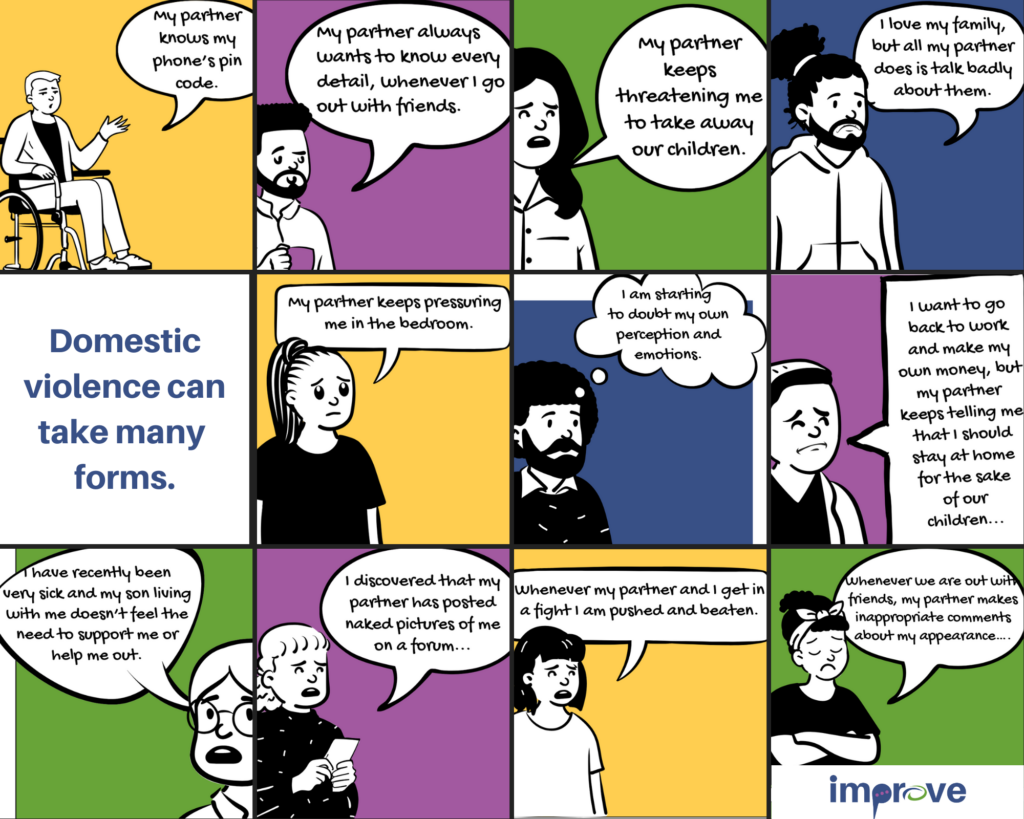
Comic 1: Coercive control
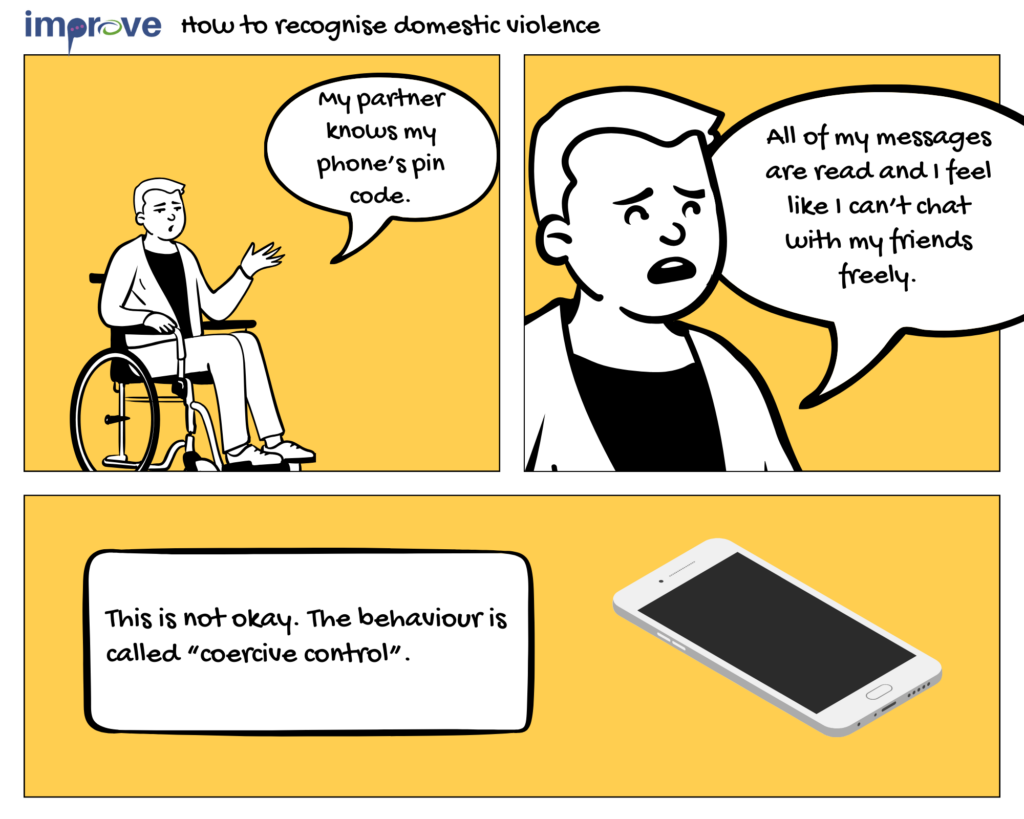
Comic 2: Stalking
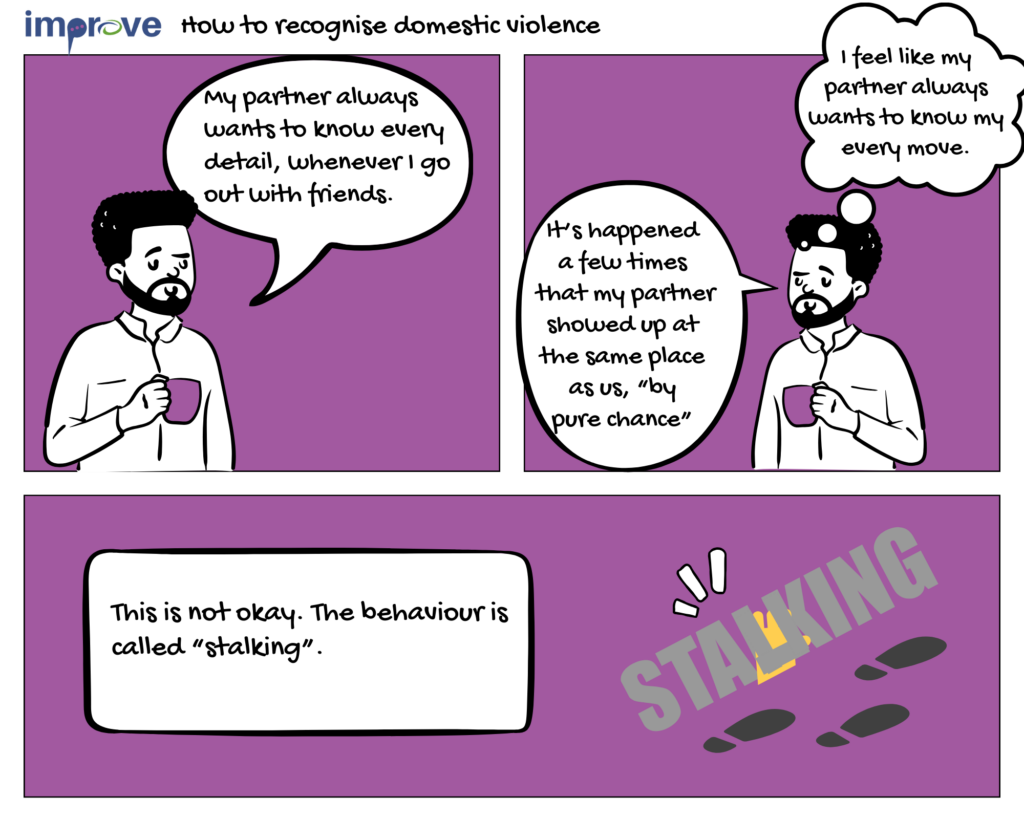
Comic 3: Psychological violence

Comic 4: Social violence
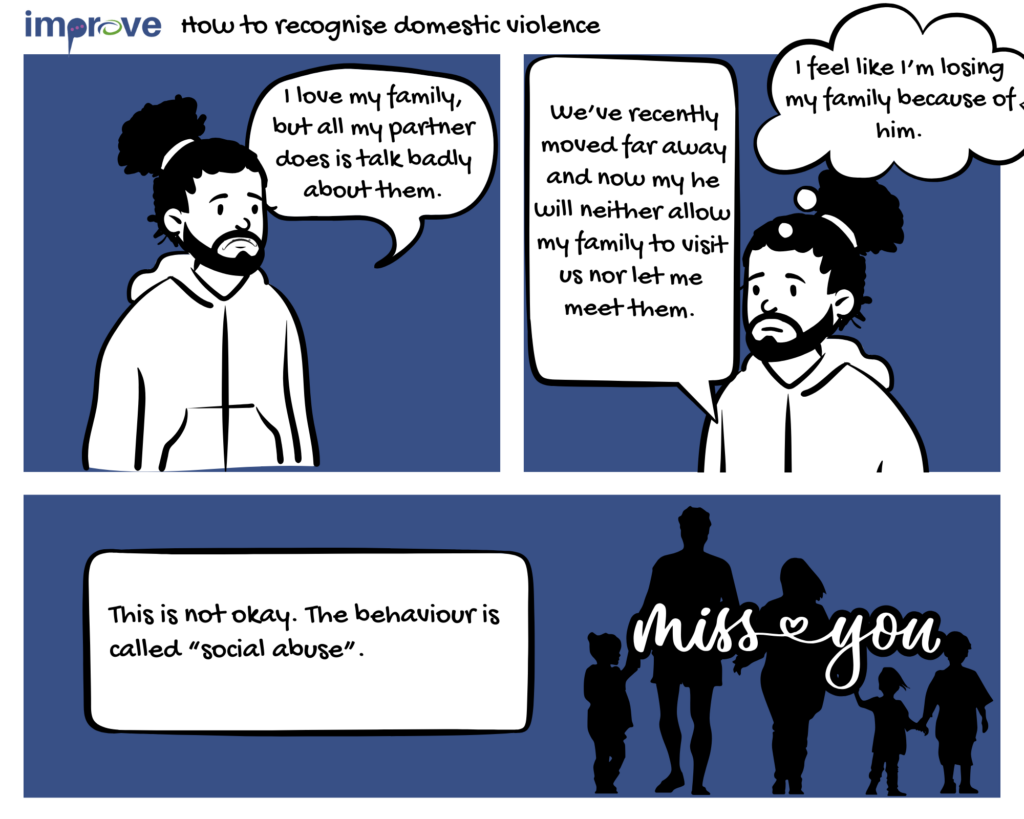
Comic 5: Sexual violence

Comic 6: Neglect
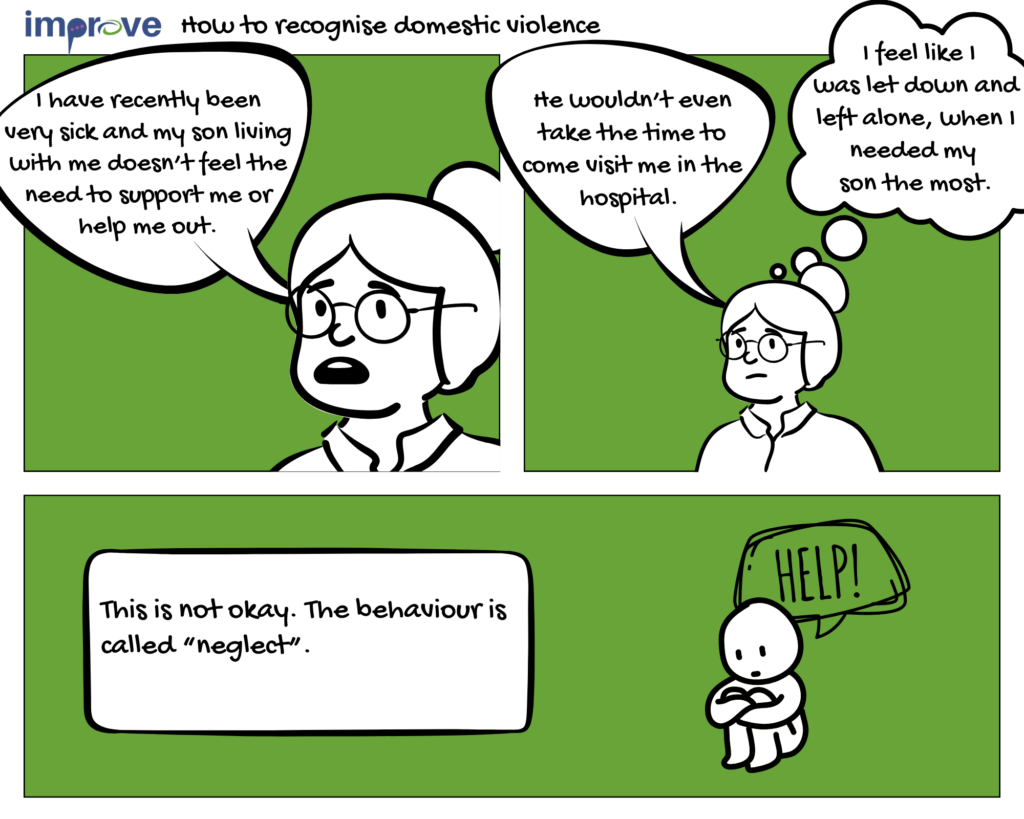
Comic 7: Economic violence

Comic 8: Gaslighting

Comic 9: Physical violence
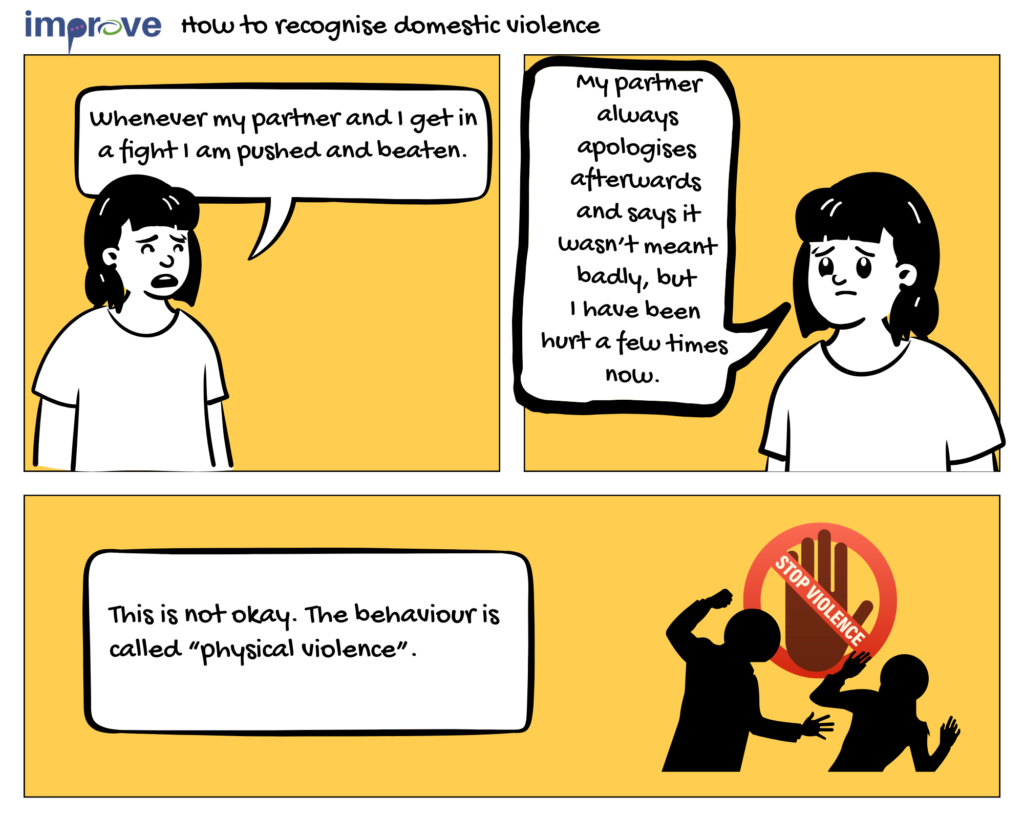
Comic 10: Digital violence
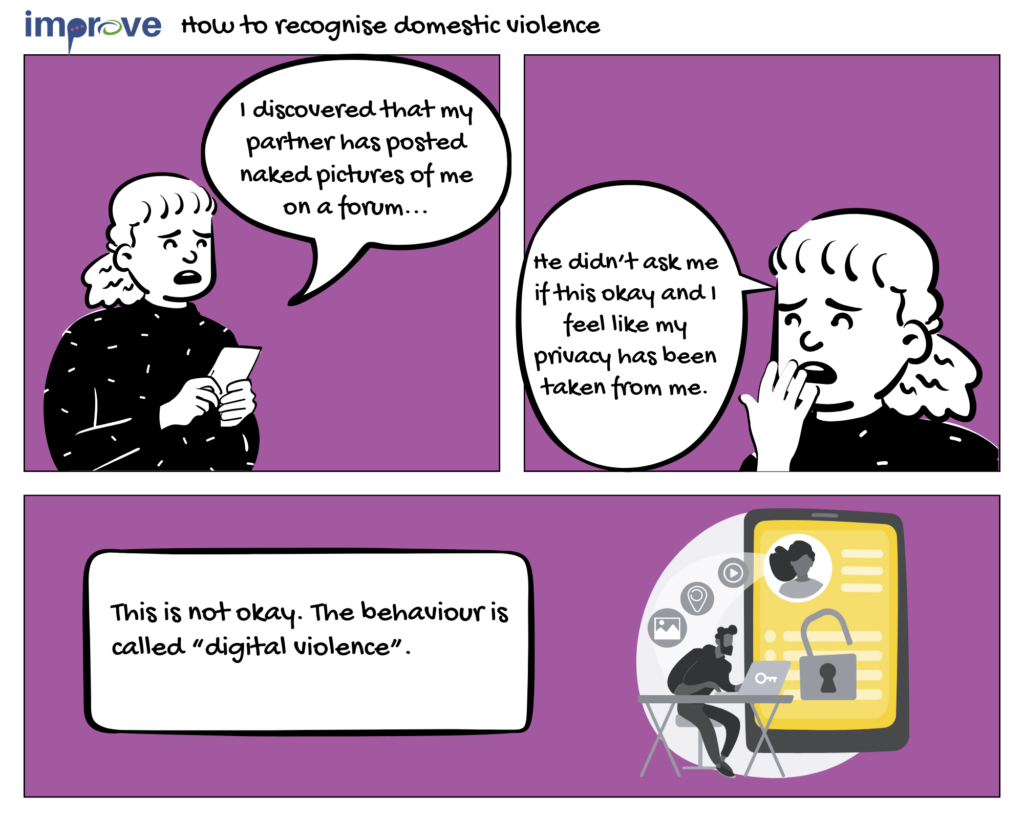
Comic 11: Verbal violence
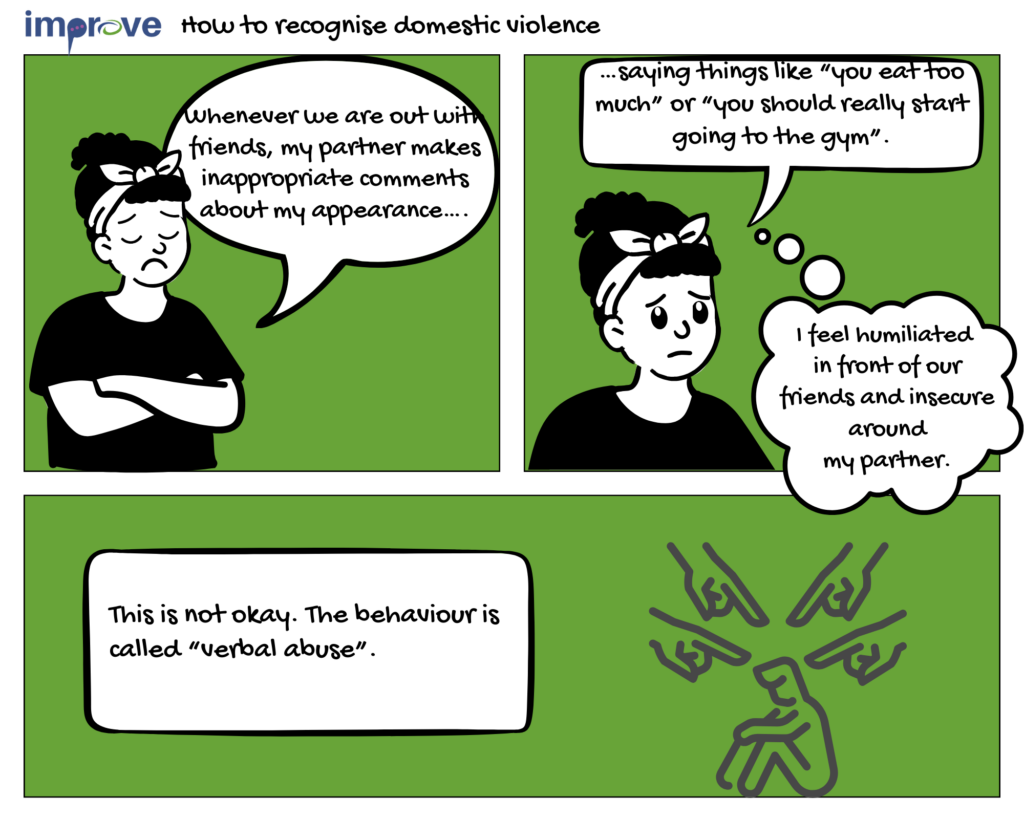
Case studies
Elderly
Winnie, aged 69 years, lives by herself in a small country town. She has been a patient of yours for a number of years. She has severe arthritis and requires more and more help with the activities of daily living. Even with regular visits from community services, she finds it difficult to cope, but she is adamant that she doesn’t want to go to the regional hospital.
Eventually, she moves in with her daughter and husband and their young sons. The neighbours begin to complain about the noise. Since Winnie has moved in, there is not much space in the house and the children are fighting more often, they are shouting and playing outside more often. Winnie’s daughter does not receive any help from her sisters and is expected to cope with the increased washing, cooking and other duties without complaint.
When you make house calls to Winnie you notice that she has marks and bruises on her arms and upper torso. These are explained away by her daughter, who says that she is becoming clumsier and keeps knocking into things, also Winnie is taking blood thinners. Winnie just shakes her head and says nothing, when you ask her if everything is okay at home, even when you speak to her in private. You are worried about pressing the issue since you do not want to upset anybody by raising a false alarm.
Adapted from a case study from RACGP (2014): Abuse and Violence: Working with our patients in general practice
Further tasks for reflection
Discuss the case study.
(1) What would you do when being Winnie’s physician in this situation?
(2) What are the main risk factors for Winnie to suffer from domestic violence?
Men as victims
4:34 p.m. Argument in the parking lot of a shopping mall
An outcry from Mrs. E. is audible when her head hits the roof of the car above the driver’s entrance. Passers-by then notice a loud argument and scuffle between the couple. When the couple gets into the car to start driving, a driver blocks them with her vehicle. Mr. E. then flees.
4:37 p.m. Emergency call at the emergency control centre
One of the bystanders calls the police.
4:50 p.m. Police car arrives on scene
The report of Mrs. E. and the witnesses cannot fully clarify what happened. Witnesses say that they have seen that Mr. E. was violent towards Mrs. E. HOWEVER, Mrs. E. said that they had merely argued, whereupon she got into the car frantically and injured her head. They continued to fight afterwards and wanted to drive home but were prevented from doing so. Mr. E. had probably fled in panic, because of the violent verbal attacks by bystanders.
The police officers took down the statements and personal details of the witnesses and of Mrs. E. During this process, Mrs. E. is also asked questions which serve to assess the danger of being attacked again. Mrs. E. refuses a medical examination and is informed of the possibility of having her injury documented in a violence protection outpatient clinic in the following days in a legally secure, cost-free and, if necessary, anonymous manner. After Mrs. E. has been informed about her victim rights, one of the two policemen sensitively addresses the issue of domestic violence and points out the possibilities of specialised counselling and the proactive approach. Mrs. E. listens to these hints and the explanation of police protection options (judicial protection order according to the Protection against Violence Act, approaching endangered persons, expulsion, accommodation in a women’s shelter), but remains firm that everything is fine at home. She refuses any support and the information flyer offered to her. Since the overall circumstances indicate a case of domestic violence, the police officers inform Mrs. E. that they are initiating an investigation against her husband for physical injury and hand her a victim protection leaflet with the police’s case number.
Mrs. E. finally makes her way home alone and, because of her head injury, by public transport.
7:14 p.m. Emergency call in the control center
An emergency call is received at the control centre from neighbours due to disturbing noise in Mr. and Mrs. E.’s apartment.
7:35 p.m. Police intervention in the apartment of couple E.
Two police cars arrive at the address of the couple since the afternoon’s operation and the address of couple E. are already stored in the police system. The police officers assume that there could be another incident of domestic violence. The police crew entering the apartment immediately see that the couple and Mrs. E.’s mother are intoxicated. When questioned separately, all three parties trivialize the incident and state that they were upset that Mr. E. had fled in the afternoon, leaving his wife alone with the police and a head injury. As there are no visible injuries either to Mr. E. and Mrs. E.’s mother, and there are no concrete indications of a criminal offence, those present are urged to remain calm and are informed that if the police are called in again, a report of an administrative offence will be made for disturbing noise.
9:44 p.m. Emergency call in the operations centre
Again, an emergency call from the neighbours for disturbing the peace. The neighbours say, “Things are really getting lively next door. I think they’re having another one of their problems.”
10:10 p.m. Police action at the home of couple E.
Due to the suspicion that this is a case of domestic violence, two police cars arrive again. Among them are police officers from the previous operation in the apartment of family E. They find that the degree of alcohol intoxication of couple E. as well as of Mrs. E.’s mother seems to be much higher compared to the previous visit. Furthermore, all those present show traces of blood, injuries to hands, arms, and face. Mr. E.’s injuries are particularly serious.
Once again, all three persons are heard separately, whereby Mrs. E. and her mother state that Mr. E. began to become violent towards them and they had to defend themselves.
Mr. E. breaks down crying in front of an official and says that he could not stand the violence by his wife and mother-in-law which had been going on for years and that he did not know what else to do that evening but to become violent as well. In spite of his strong intoxication, Mr. E. appears credible and provides conclusive information about the crime and the violence to date.
Mrs. E. and her mother are confronted with the information provided by Mr. E., whereupon they react verbally in a very aggressive manner, and both want to attack Mr. E. in order to “show him what it means to spread such lies about them”. Further violent assaults on Mr. E. can be prevented by the police forces deployed.
Mr. E. wants to leave the apartment and can only be accommodated in a homeless shelter due to the lack of a special accommodation for men as victims of domestic violence. He would like to contact a counselling centre for men affected by domestic violence the very next day and have his injuries documented in an outpatient violence protection clinic. In contrast to Mrs. E. and her mother, he agrees to immediate medical treatment of his injuries. To treat his injuries, Mr. E. is driven to the nearest hospital by an ambulance car. From there, he goes to the emergency shelter on his own. Once again both women reaffirm that they only “had to defend themselves” against the attacks of Mr. E. As a result, the police assesses the risk of Mr. E. becoming the victim of violent assaults by his wife and her mother again as very likely.
In the following days and weeks
In the course of further investigations, the witnesses of the first argument in the parking lot and a neighbour of the E. family are questioned by the police. Mr. E. makes an extensive statement to the police, in which he again describes the development and successive increase in violence against him, as well as his fear that someone may discover that he is a victim of violence in his relationship.
The forensic medical report of the violence protection outpatient clinic is also included in the investigation, which supports the course of events as described by Mr. E. Mrs. E. and her mother only make statements regarding the criminal charges of assault against Mr. E. In doing so, they stick to their original version that Mr. E. caused the escalation of violence but become entangled in contradictions which are documented. With regard to their charge of grievous bodily harm against Mr. E., both make use of their right to refuse to give evidence.
Mr. E. seeks advice from a specialised counselling centre for men affected by domestic violence. He is granted the sole use of the marital home.
After four weeks, the police investigations are concluded with the result that Mr. E. has apparently been a victim of violence by his wife and her mother for years. Both incidents are sent to the Special Department for Cases of Domestic Violence of the District Attorney’s Office for further decision.
Task of reflection
(1) Examine your own attitudes and beliefs about male victims of domestic violence. Reflect on any biases you might hold and consider ways to be more supportive and empathetic towards all survivors.
(2) Analyse cultural norms and beliefs surrounding masculinity and how they can discourage male victims from reporting abuse or seeking help. Reflect on ways to challenge and redefine harmful gender stereotypes that hinder support for male victims.
(3) Consider the intersection of other identities such as race, ethnicity, sexual orientation, and socioeconomic status with male victimisation.
Refugees and migrants
Nora is a 34-year-old woman with an immigrant background. She has lived here in your country for three years with her parents and sisters. Nora married Peter two years ago. Peter is the son of a family friend of Nora’s parents. Nora’s family comes from a patriarchal culture where the community comes before the individual.
Nora’s marriage with Peter was a relief for Nora’s family since in their culture a woman at Nora’s age should not be single. However, quite soon after Nora and Peter got married, Peter started to control her everyday behaviour. Peter does not let Nora see her friends or go anywhere without him. A mandatory language course is the only place where Nora can go alone.
Peter takes away Nora’s debit card and takes loans under her name. When Nora tries to resist, Peter turns violent and abuses her. Peter threatens to send Nora back to her home country.
Nora discloses the situation to her parents, asking for help. First, the parents take Peter’s violent behaviour seriously, but suddenly Nora’s father passes away. Nora’s grieving mother is not capable of standing against Peter’s will on her own.
At the same time, Peter spreads rumours about Nora’s immorality in order to justify the claims of his violent actions to their community. The rumours humiliate Nora’s family. The community pressures Nora’s mother and her sisters’ families to clear their name.
Nora’s mother begs Nora to stay with Peter to calm the situation and her sisters ask her not to bother their mother with the issue any more. Nora feels that she is responsible for the violence and her family’s reputation, and accepts that divorcing Peter is out of the question.
Over time, the violence gets more serious and more frequent. On one occasion, Peter strangles Nora for so long that she loses consciousness. After the strangulation, she starts to have speech impairment issues especially in stressful situations. Nora feels isolated, helpless and depressed.
Peter has threatened to share some private pictures of Nora in public if Nora ‘ruins his reputations as a husband’, as he puts it. Nora feels anxious since she cannot talk to anyone – even her family – about her feelings.
Task for reflection
This was the story of Nora. Please think about the following questions:
(1) What types of domestic violence is Nora experiencing?
(2) Which acts, situations or conditions endanger Nora?
(3) Which situations described in the case study you consider unfortunate but not for your business as a frontline responder?
Children and youth
Gabby married her husband Nick after a long relationship and shortly thereafter moved to her husband’s family farm. The couple was happy at the farm and soon had their first child. During the pregnancy Nick’s behaviour began to change and by the time their daughter was born the relationship did not ‘feel’ as it had before. Nick seemed withdrawn and spent long periods of time by himself. He began to remind Gabby of Nick’s father who had always been a stern presence in his life.
Nick’s behaviour became threatening and controlling, especially in relation to money and social contact. He was increasingly aggressive in arguments and would often shout and throw objects around the room. Gabby thought that, because he wasn’t physically hurting her, his behaviour did not qualify as abuse. Nick did not show much interest in their daughter, Jane, except when in public, where he would appear to be a doting and loving father.
Jane was generally a well-behaved child, however, Gabby found that she was unable to leave her with anyone else. Jane would cry and become visibly distressed when Gabby handed her to someone else to be nursed. This was stressful for Gabby, and also meant that her social activities were limited further.
Jane took a long time to crawl, walk and begin talking. Her sleeping patterns were interrupted, and Gabby often did not sleep through the night, even when Jane was over 12 months of age. When Jane did begin to talk, she developed a stutter, and this further impeded her speech development. Gabby worried about Jane a lot. Their family doctor told her that this was normal for some children and that, if the speech problems persisted, she could always send Jane to a specialist at a later date.
After a number of years, Nick’s behaviour became unacceptable to Gabby. During arguments he would now hold on to the rifle that he had for farming purposes, and Gabby found this very threatening. On a number of occasions, items that Nick threw hit Gabby and she was increasingly afraid for their daughter. Gabby decided to leave and consulted the local women’s service, who assisted her to get an intervention order against Nick.
Once Gabby had taken Jane away from Nick, her behaviour changed. Jane’s development seemed to speed up and Gabby couldn’t understand why. As part of her counselling at a local women’s service, she discussed this issue, and her counsellor recognised the developmental delay, stutter, irritation, and separation anxiety as effects of Jane’s previously abusive situation.
This can be seen as a missed opportunity for identifying family violence. If the family doctor would have asked Gabby or Nick (who had presented with chronic back pain) about their relationship, about what was happening to the family, and specifically to Jane, the situation could have been identified much earlier.
Further tasks for reflection
(1) What could have been done better by those involved?
(2) Take a moment to consider which agencies and professionals should have been involved in supporting and/or providing services to Gabby from the beginning.
Adapted from a case study from RACGP (2014): Abuse and Violence: Working with our patients in general practice
Factsheets
Knowledge assessment – Final exam
Final exam to be used for knowledge assessment after completing Module 1.
If you do not see the video here, please use another browser or click here: www.youtube.com/watch?v=YlHxhmOsrHo.
Tasks to do
Please watch the video and provide responses to the following questions:
(1) Identify and describe all forms of domestic violence portrayed in the video and how the victim experienced each type.
(2) Provide examples of the “cycle of violence” that are evident in the video.
(3) Identify the reasons presented in the video as to why the victim did not escape the violence.
Further training materials
Quiz: Forms of domestic violence
Quiz: Gender-based violence

